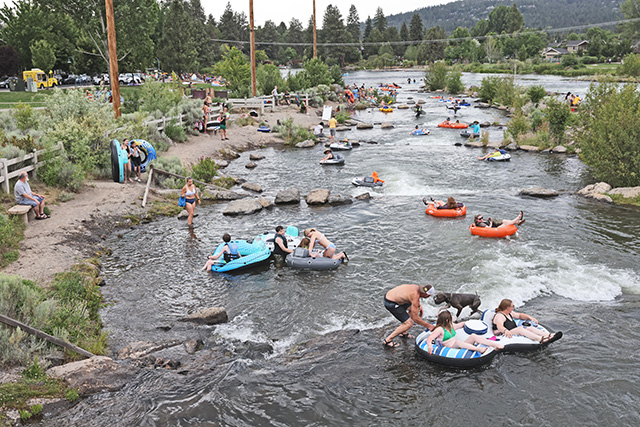Slow cooking, Mediterranean-style
Published 4:00 am Tuesday, January 22, 2013
If a glance at your slow cooker reminds you of the same three or four dinners (chili, pot roast, bean soup or pulled pork), it’s time to try something new.
Diane Phillips, cooking instructor and author of 15 cookbooks, including “Slow Cooker: The Best Cookbook Ever,” says the slow cooker was made for Mediterranean foods and flavors.
She proves it in her new book, “The Mediterranean Slow Cooker Cookbook,” a paperback from Chronicle Books, with recipes from Spain, Portugal, France and Italy as well as Tunisia, Egypt, Turkey, Morocco and Greece.
“There’s a lot of Mediterranean food that actually sits on the back of the stove for most of the day, like beef bourguignon, or Grandma’s sauce or a soup. Even in the southern Mediterranean or North African countries, they have lentils sitting on the stove,” Phillips said in a phone interview from her home in San Diego.
In her new book, Phillips takes more than 100 recipes from countries that border on the Mediterranean Sea and turns them into slow cooker standouts.
A final chapter is dedicated to Mediterranean sauces and condiments that can be made in a slow cooker, from basic marinara sauce and caponata (a spicy and salty relish or side dish loaded with onions, olives, garlic, eggplant, bell peppers and tomatoes), to balsamic caramelized onions and a fig and onion jam.
“I look at a slow cooker as a low and slow oven. There are so many things you can do with them. I never thought you could make lasagna in a slow cooker, but it’s better than the oven because it doesn’t dry out. The cheese and sauce melt together. Low and slow cooking makes it out-of-this-world good,” Phillips said. (See recipe for Lasagna Bolognese. The sauce can be made in a slow cooker in advance, and then the lasagna can be assembled and cooked in the slow cooker.)
Phillips cautions the home cook that inexpensive slow cookers tend to cook at high temperatures, even when they’re set on “low.”
She tested many different slow cookers as she wrote her new cookbook, and was surprised at what she found.
“Inexpensive slow cookers set on “high” are supposed to register 300 degrees, but most go to 375 degrees. At “low,” most are in the 300 degree range, so if you have an inexpensive model, you should cook everything on “low” for the amount of time a recipe calls for the “high” temperature.
“I stopped testing recipes with the inexpensive cookers because I was burning everything,” Phillips told us.
High-end slow cookers can be programmed to switch from “high” or “low” to “warm” after a designated period of time, ensuring that recipes are not overcooked.
More expensive slow cookers have other appealing features.
“Three of the high-end manufacturers now offer slow cookers with an insert that can be used on the stove top, eliminating the need for a large skillet. After you saute your flavor base ingredients or meat in the insert, you place it in the slow cooker, and you are good to go,” Phillips writes in “The Mediterranean Slow Cooker Cookbook.”
Mediterranean fish dishes like Moroccan Seafood Stew (see recipe) won’t be overdone when cooked in a slow cooker — even an inexpensive one.
The recipe calls for two hours of cooking on “high,” which means the “low” setting on an inexpensive slow cooker that tends to run hot, according to Phillips.
“A slow cooker won’t overcook fish, because it’s a low, slow heat. You could put that on before you take the kids to ballet or soccer practice, and then have dinner ready when you come home. I’ve gotten lots of emails from readers who love that Moroccan stew. Sea bass is a no brainer. Its protein structure makes it almost impossible to overcook,” Phillips said.
Another secret to great-tasting slow cooker food is building flavors by always sauteing ingredients before adding them to the cooker.
“I’m pretty lazy. I like things that help me in the kitchen, like the slow cooker. I don’t have to baby this thing. But my mantra is, ‘Take the 15 minutes to do what you need to do’; it really makes a difference to saute the onion and garlic. If you don’t, all you’re going to taste is the harshness. If you don’t cook the protein to seal in the juices, you get this ugly foam that forms on the top, and you don’t get the caramelization in the pan that gives you a deeper flavor,” Phillips said.
Her Beef in Barolo wine recipe (see recipe) also requires some overnight marinating.
“It’s hearty, it’s wonderful, and because we marinate it overnight, it’s got lots of flavor to begin with, and with the slow cooking, it falls apart, and it’s just delicious,” she said.
The next time you’re in the mood for a slow cooker meal — a “set it and forget it” — as Phillips calls it, think Mediterranean, and you’ll have a meal in the style and with the flavors of a region that has been making famously low, slow and delicious food for many generations.







